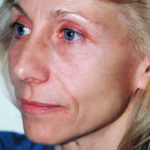The earliest signs of facial aging often appear in the midface area, a triangle defined by the inner and outer corners of the eye and the corner of the mouth. There may be loose lower eyelid skin and bulging fat bags. The line of demarcation between the lower eyelid and the cheek (lid/cheek junction) begins to drift lower. In addition, the cheek tissues slowly fall downward, making the nasolabial fold more prominent. The aging midface area can look a little like wax melting off a candle.
Traditional plastic surgical procedures are ineffective in correcting these midface problems, even when a lower blepharoplasty and facelift are done at the same time.. The classic lower eyelid tuck could remove excess skin and fat bags, but could do nothing with the fallen cheek tissues. The traditional facelift, or neck-jowl lift, offers virtually no changes in the cheek, nose, and upper lip area despite that many patients believe that it will.
As a result, the midface lift (not a facelift) procedure has emerged to correct this historically unreacheable aging area. The midface lift is done through an incision immediately below the lashes of the lower eyelid and extends slightly out from the outer corner of the eye in a crease line. By dissecting down to the cheek bone, the fallen cheek tissues are separated from the bone, lifted vertically, and put back up in a higher position on the cheek bone. Excess lower eyelid skin and fat can also be removed if necessary after the cheek tissue is repositioned. (which is almost always needed) The eyelid incisions are closed with dissolving sutures under the lashline and very small sutures out into the crease skin.
One of the keys to a good and stable midface lift is where to secure the cheek tissues which are lifted up by sutures. Here is a point of plastic surgery debate and different surgeons have their own methods. In my Indianapolis plastic surgery practice, I prefer to use a high cranial suspension point which is immediately vertical to the direction of upward pull. This requires a small incision in the scalp above the temporal area.

A midface lift is often done with upper and lower eyelid tucks (blepharoplasty) at the same time, or even a facelift. As a result, the eye and cheek area will get fairly swollen and bruised after and the corners of the eye will feel tight. One will not look fairly reasonable in most cases until about 7 to 10 days after surgery. (non-operated look) One should be capable of returning to sedentary-type work – perhaps with some camouflage makeup – within a week after surgery. More vigorous activites must usually await three to four weeks until one is ready.
Dr. Barry Eppley
Indianapolis, Indiana



